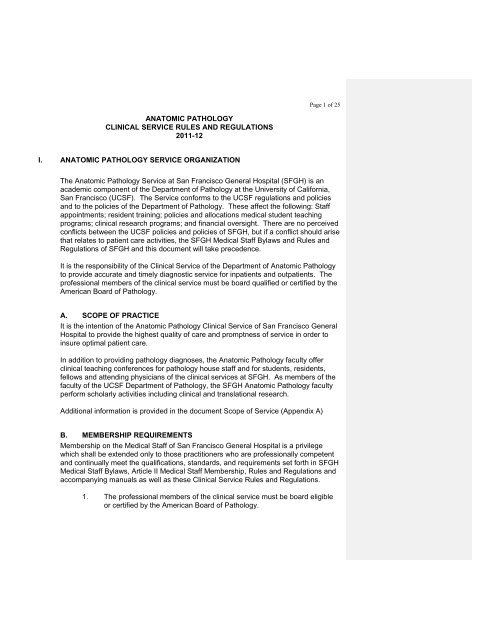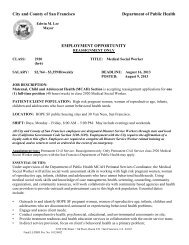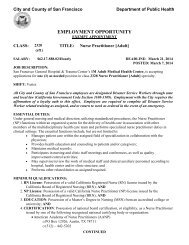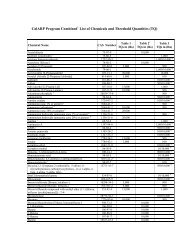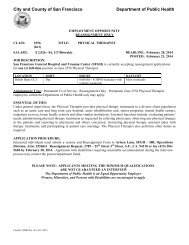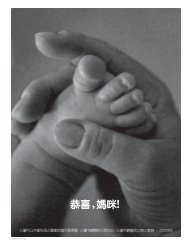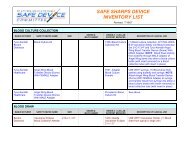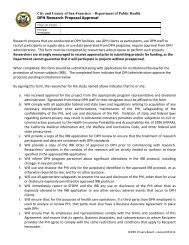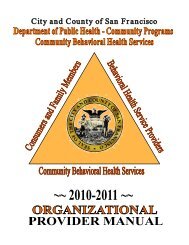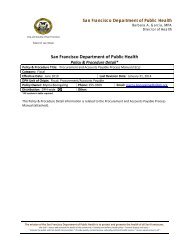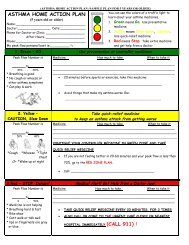anatomic pathology clinical service rules and regulations
anatomic pathology clinical service rules and regulations
anatomic pathology clinical service rules and regulations
Create successful ePaper yourself
Turn your PDF publications into a flip-book with our unique Google optimized e-Paper software.
Page 5 of 25III.DELINEATION OF PRIVILEGESA. DEVELOPMENT OF ANATOMIC PATHOLOGY PRIVILEGESAnatomic Pathology privileges are developed in accordance with SFGH MedicalStaff Bylaws, Article V: Clinical Privileges, Rules <strong>and</strong> Regulations.B. ANNUAL REVIEW OF ANATOMIC PATHOLOGY CLINICAL SERVICEPRIVILEGE REQUEST FORMThe Anatomic Pathology Clinical Service Privilege Request Form shall bereviewed annually.C. CLINICAL PRIVILEGESAnatomic Pathology Clinical Service privileges shall be authorized inaccordance with the SFGH Medical Staff Bylaws, Article V: Clinical Privileges,Rules <strong>and</strong> Regulations. All requests for <strong>clinical</strong> privileges will be evaluated <strong>and</strong>approved by the Chief of the Anatomic Pathology Clinical Service.The process for modification/change of the privileges for members of theAnatomic Pathology Service is in accordance with the SFGH medial StaffBylaws <strong>and</strong> the Rules <strong>and</strong> Regulations.D. TEMPORARY PRIVILEGESTemporary Privileges shall be authorized in accordance with the SFGH MedicalStaff Bylaws, Article V: Clinical Privileges, Rules <strong>and</strong> Regulations.IV.PROCTORING AND MONITORINGA. MONITORING (PROCTORING) REQUIREMENTS1. Staff PhysiciansThe duration of proctoring in Anatomic Pathology for a new appointment is asix (6) month period. The Chief completes, signs, <strong>and</strong> provides a copy ofthe Proctoring form to Medical Staff Services Department.Proctoring shall consist of both concurrent observation <strong>and</strong> retrospectiveevaluation. The required numbers of specimens <strong>and</strong> procedures (FNA) thatmust be observed or reviewed for each privilege are listed in Appendix E(Anatomic Pathology Clinical Service Privilege Request Form. In theAnatomic Pathology Clinical Service, at least 25% of the cases of diagnosticimportance are seen by a second pathologist during the initial time ofevaluation. An estimate of the numbers <strong>and</strong> types of cases concurrentlyexamined by a proctor <strong>and</strong> appointee during the six-month period are part ofthe proctor’s evaluation. In addition, a retrospective review of theappointee’s performance is available through an evaluation of <strong>clinical</strong>indicators for that period, such as frozen section-final diagnosis correlation,
Page 7 of 25VI.ANATOMIC PATHOLOGY CLINICAL SERVICE HOUSESTAFF TRAININGPROGRAM AND SUPERVISIONAll the Pathology Residents are actively involved in all aspects of the AnatomicPathology Clinical Service. These include:• Frozen Section in the Operating Room• Fine Needle Aspiration Biopsies in Wards <strong>and</strong> Clinics• Performance of Autopsies• Microscopic Review of Autopsies <strong>and</strong> Preparation of Autopsy Reports• Analysis of Diagnostic Biopsies <strong>and</strong> Preparation of Reports• Dissection of Specimens received from the Operating Room <strong>and</strong> Preparation ofReportsAll procedures are performed under the supervision of an attending pathologist. All<strong>anatomic</strong> dissections, autopsies <strong>and</strong> surgical specimens, are reviewed with anattending. Every microscopic slide is reviewed with a staff pathologist. Each finaldiagnostic report is reviewed <strong>and</strong> signed by a pathologist.At interdepartmental meetings <strong>and</strong> working <strong>service</strong> conferences, the Resident maypresent the <strong>pathology</strong> findings. This is always done following preparation with anattending.Resident evaluation is coordinated through a centralized evaluation process in theDepartment of Pathology at UCSF. This involves a web-based evaluation system ofcompetencies. Each Attending Physician fills out a performance assessment at theend of the resident rotations. These are used by the Residency Director as a bais forassessment of performance <strong>and</strong> advice regarding improvement. Residentperformances are also discussed among Pathology Attending Staff of all UCSFhospitals at quarterly meetings.VII.VIII.IX.ANATOMIC PATHOLOGY CLINICAL SERVICE CONSULTATION CRITERIARefer to X. B. Below - Anatomic Pathology Clinical Service PoliciesANATOMIC PATHOLOGY CLINICAL SERVICES DISCIPLINARY ACTIONThe San Francisco General Hospital Staff Bylaws, Rules <strong>and</strong> Regulations will governall disciplinary actions involving members of the SFGH Anatomic Pathology ClinicalService including provision for due process where applicable.PERFORMANCE IMPROVEMENT & PATIENT SAFETY (PIPS)The Anatomic Pathology Clinical Service is committed to the maintenance of thehighest st<strong>and</strong>ards of practice <strong>and</strong> dedicated to the continued efforts to improve <strong>clinical</strong><strong>service</strong> performance. Performance Improvement <strong>and</strong> Patient Safety for the AnatomicPathology Clinical Service is includes ongoing monitoring <strong>and</strong> evaluation of the qualityas it relates to patient care. The goal is to identify <strong>and</strong> resolve problems within theClinical Service that impact on patient care.
Page 8 of 25The Chief of Anatomic Pathology is responsible for the quality of <strong>service</strong> provided bythe <strong>clinical</strong> <strong>service</strong> <strong>and</strong> its impact on patient care. The Chief of Anatomic Pathologyreviews reports of performance improvement <strong>and</strong> patient safety activities in the <strong>clinical</strong><strong>service</strong> or delegates responsibility for formulating, monitoring, reporting, <strong>and</strong>communicating the PIPS Plan to a designated the physician within the<strong>service</strong><strong>pathology</strong> attending staff. Performance Improvement <strong>and</strong> Patient Safetyactivities are discussed at the Anatomic Pathology monthly meetings. A quarterlyTissue Committee report is prepared <strong>and</strong> presented to the Hospital PIPS Committee.A Departmental Report is presented to Hospital PIPS Committee annually.A full description of the Anatomic Pathology Clinical Service PIPS plan is provided inthe document, San Francisco General Hospital Anatomic Pathology PIPS Program(Appendix D). This document is revised annually.A. Anatomic Pathology Clinical IndicatorsThe <strong>clinical</strong> indicators for Anatomic Pathology include:• Specimen identification• Insufficient tissue on FNA• Correlation of frozen section <strong>and</strong> final diagnoses• Correlation of abnormal cytology results <strong>and</strong> tissue diagnoses.• Correlation of autopsy Provisional Diagnoses with Final Diagnoses• Notification of critical values• Notification of critical diagnoses• Turnaround times for surgical <strong>pathology</strong>, dermato<strong>pathology</strong>, autopsy<strong>pathology</strong> <strong>and</strong> cytology cases.These indicators form the basis of credentialing <strong>and</strong> monitoring practicepatterns. Whenever possible, these indicators have been made physicianspecific. Updated performance summaries are included in each pathologist’spersonnel file.B. Anatomic Pathology Clinical Service Practitioners Performance ProfileRefer to San Francisco General Hospital Anatomic Pathology PIPS Program(Appendix D) <strong>and</strong> Anatomic Pathology Clinical Service Privilege Request Form(Appendix E).C. Monitoring <strong>and</strong> Evaluation of Appropriateness of Patient Care ServicesRefer to San Francisco General Hospital Anatomic Pathology PIPS Program(Appendix D) <strong>and</strong> Anatomic Pathology Clinical Service Privilege Request Form(Appendix E).
Page 9 of 25D. Monitoring <strong>and</strong> Evaluation of Professional Performance of AnatomicPathologyThe quality of performance of each pathologist in Anatomic Pathology isconstantly being monitored <strong>and</strong> evaluated. Any deficiencies are reviewed <strong>and</strong>made a part of each physician’s personnel file. Repeated deficiencies <strong>and</strong>unethical or illegal actions may constitute a deviation from st<strong>and</strong>ards ofacceptable medical care. Such cases shall be referred to the Medical StaffServices Department for action.Many Pathology cases are presented at interdepartmental conferences, <strong>and</strong> inthe process are seen by more than one member of the <strong>clinical</strong> <strong>service</strong>. Inaddition, difficult cases, highly specialized cases, <strong>and</strong> cases with a newdiagnosis of malignancy are seen by more than one member of the department.Overall, greater than 25% of cases are reviewed by more than one pathologistbecause of this conference-consultative system.The Anatomic Pathology Clinical Service also participates with otherdepartments in their performance improvement <strong>and</strong> patient safety activities.These include but are not limited to the SFGH Tissue Committee <strong>and</strong>Departmental Morbidity <strong>and</strong> Mortality Conferences.X. ANATOMIC PATHOLOGY CLINICAL SERVICE POLICIESA. Policies <strong>and</strong> procedures applicable to each subdivision of the AnatomicPathology Clinical Service are kept at each site <strong>and</strong> reviewed yearly.B. Requests for Anatomic Pathology <strong>service</strong>s are made via by a st<strong>and</strong>ard SFGHrequisition slips. For surgical <strong>and</strong> other biopsy specimens, additional formsgiving pre- <strong>and</strong> post- diagnoses (Record of Operation) or a PathologyConsultation request must be included in order to insure that adequate <strong>clinical</strong>information is available.C. Specimens received without necessary documentation are not processed untildocumentation is completed. A policy for confirming, pursuing, <strong>and</strong> reportinglost specimens is also in place.D. Records are kept of daily accession of specimens <strong>and</strong> how they are identified.E. Copies of all Anatomic Pathology reports are electronically kept.F. All microscopic interpretations are made by pathologists qualified in AnatomicPathology.G. Members of the Housestaff who perform autopsies are under the directsupervision of a pathologist.
H. The Cyto<strong>pathology</strong> Service is directly supervised by pathologists who arequalified in Cytology.Page 10 of 25• All Cytology slides of non-gynecological origin, all gynecological smearsinterpreted to be pre-malignant or malignant, <strong>and</strong> a sample of over 10%of negative reproductive tract Cytology’s are reviewed by a pathologist.• A performance improvement <strong>and</strong> patient safety program is in placeregarding Cyto<strong>pathology</strong> (Appendix D – San Francisco General HospitalAnatomic Pathology PIPS Program)• Workload limits for cytotechnologists comply with Federal <strong>and</strong> Statelaws.I. All Cyto<strong>pathology</strong>, Surgical Pathology, <strong>and</strong> Autopsy reports are part of thepatient’s Lifetime Clinical Record (LCR).J. All wet tissue, microscopic slides, <strong>and</strong> paraffin blocks are stored for as long orlonger than specified by Federal Regulations (Title 42, Code of FederalRegulations). When duration of storage is not specified in Federal Regulations,the recommendations of the College of American Pathologists are met orexceeded. Details regarding specific storage are available in the Policies <strong>and</strong>Procedures documents applicable to each subdivision of the AnatomicPathology Clinical Service (available in the Department of Anatomic Pathology).K. All Anatomic Pathology Clinical Service personnel are required to comply withrequirements for initial <strong>and</strong> a yearly review training of National Patient SafetyGoals, Bloodborne Pathogens, Clinical Infection Control, Environment of Care,Compliance, IS Security, Baby Friendly Initiative, Stroke, Response <strong>and</strong>Emergency Management, Abuse Overview, Personal Preparedness forDisaster, Privacy, N95 Respiratory <strong>and</strong> other requirements designated bySFGH Administration. Training is by attendance or certification through theHealth Stream training system.L. An Anatomic Pathology Clinical Service meeting is held monthly. PerformanceImprovement <strong>and</strong> Patient Safety matters are discussed. A report is sent to theHospital PIPS Committee, <strong>and</strong> minutes are maintained in secure Departmentalfiles.XI.INFECTION CONTROL PROGRAMA. The Anatomic Pathology Clinical Service participates in the SFGH InfectionControl Program. All personnel complete annual m<strong>and</strong>atory infection controltraining.B. The Anatomic Pathology Clinical Service adheres to requirements of theEmployee Health Service (CMOSH) regarding screening <strong>and</strong> immunizationrequired for employees at SFGH.
Page 11 of 25C. A Body Substance Precaution Program made specific for the Department ofPathology is followed <strong>and</strong> updated as needed. It is approved yearly by theInfection Control Committee at SFGH.D. Reporting of Communicable Diseases to the Public Health Department1. Title 17, Chapter 4, Section 2505 of the California Administrative Code,require the Reporting to the City Health Department of laboratory findingssuggestive of diphtheria, gonorrhea, syphilis, tuberculosis, typhoid, <strong>and</strong> listeria.Section 2503 requires that the laboratory report any unusual isolate to the CityHealth Department. Section 2503 requires reporting of a suspected infectiousdisease outbreak.XII.HAZARDOUS SUBSTANCE PROGRAMA Hazardous Communication Program insures the right of employees to be informedregarding any hazardous substances that might be encountered in the work place.A. Components of the Hazardous Communication Program include:• Material Data Sheet Collection• Labeling Program• Hazardous Waste Disposal• Periodic Testing for common hazardous substance• EducationB. The Environmental Health <strong>and</strong> Safety Department has made available a sitespecifictraining program since 1992.C. Problems regarding Health <strong>and</strong> Safety issues are communicated to theEnvironmental Health <strong>and</strong> Safety Committee at SFGH.XIII.MEETING REQUIREMENTSIn accordance with SFGH Medical Staff Bylaws all Active members are expected toshow good faith participation in the governance <strong>and</strong> quality evaluation of the MedicalStaff by attending a minimum of 50% of all committee meetings assigned, <strong>clinical</strong><strong>service</strong>s meetings <strong>and</strong> the Annual Medical Staff Meeting. As defined in the SFGHMedical Staff Bylaws, a quorum is constituted by at least three (3) voting members ofthe Active Staff for the purpose of conducting business.The Anatomic Pathology Clinical Service meets monthly (see X.L)XIV.ADOPTION AND AMENDMENTThe Anatomic Pathology Clinical Service Rules <strong>and</strong> Regulations will be adopted <strong>and</strong>revised by a majority vote of all Active members of the Anatomic Pathology ClinicalService annually at a quarterly held Anatomic Pathologic Faculty Meeting.
Page 12 of 25APPENDIX A – SCOPE OF SERVICE2010 - 2011DEPARTMENT OF ANATOMIC PATHOLOGYSan Francisco General HospitalScope of ServiceANATOMIC PATHOLOGY VISION, MISSION AND SCOPE OF SERVICEThe Pathology Department seeks to provide the highest quality <strong>service</strong> to the citizens of the City <strong>and</strong> Countyof San Francisco. We serve a broad range of patients <strong>and</strong> <strong>service</strong>s at SFGH, including the EmergencyDepartment, Operating Room, hospital <strong>and</strong> community-based primary care clinics, <strong>and</strong> specialty clinics. Wealso serve Laguna Honda Hospital, Community Health Centers, Community Consortium Clinics, <strong>and</strong> otherDPH manage care-contracted partners. The department provides a vital teaching function as part of theMedical School of the University of California, San Francisco.Thus, the Department of Pathology at SFGH aspires to be a leading <strong>pathology</strong> department based at a publichospital.The mission of the Department of Pathology at SFGH is serving our patients, students <strong>and</strong> communitythrough our commitment to:• Delivering excellent diagnostic <strong>service</strong>s for our patients• Providing outst<strong>and</strong>ing education for our students• Developing innovative research programs with the hope that new knowledge will yield moreaccurate diagnoses <strong>and</strong> improved therapies• To support the <strong>clinical</strong>, educational <strong>and</strong> research missions of our SFGH <strong>and</strong> UCSF colleaguesThe goals of the Department of Pathology at SFGH are:• Delivering excellent diagnostic <strong>service</strong>s for our patients• To provide a wide range of <strong>pathology</strong> <strong>service</strong>s in a cost-effective, accurate, <strong>and</strong> timely manner•• To facilitate completion of complex diagnostic tests that <strong>and</strong> consultative reviews are not currentlynot performed at SFGH.• To seek consultative reviews from outside experts as needed to establish accurate diagnoses• To maintain patient confidentiality <strong>and</strong> information security while maintaining a timely <strong>and</strong> completereporting of important medical informationFormatted: Font: 12 ptFormatted: Font: 12 ptAVAILABLE SERVICESThe following Pathology <strong>service</strong>s are available 24-hours a day, 7 days a week. Services are provided topatients of all age groups <strong>and</strong> cultures.ServiceCyto<strong>pathology</strong>Surgical PathologyAutopsy PathologyExplanationGynecologic specimens (PAP smears), nongynecologicspecimens such as sputum or bodyfluid samples <strong>and</strong> fine needle aspirations (FNA’s).Specimens range from large multipart specimensreceived from surgery to small biopsies performedin <strong>clinical</strong> settings.Post-mortem examination.Electron microscopy <strong>and</strong> Immunocytochemistry <strong>and</strong>
Page 13 of 25Special ProceduresElectron MicroscopyConsultationother : special procedures are applied to selectedcases in order to provide more accurate diagnoses.Pathology specimens requiring ultrastructuralanalysis are prepared in the SFGH laboratory.Electron microscopy is performed by UCSFpathologists in the UCSF Electron Microscopylaboratory.Neuro<strong>pathology</strong>, immuno<strong>pathology</strong>,hemato<strong>pathology</strong>, dermato<strong>pathology</strong>, <strong>and</strong>nephro<strong>pathology</strong>.GOALS• To provide a wide range of <strong>pathology</strong> <strong>service</strong>s in a cost-effective, accurate, <strong>and</strong> timely manner.• To facilitate complex diagnostic tests <strong>and</strong> consultative reviews not performed at SFGH. Animportant aspect of this goal is physician education in the form of interdepartmental consults <strong>and</strong>conferences.• To maintain patient confidentiality <strong>and</strong> information security while maintaining a timely <strong>and</strong> completereporting of important medical information.• To maintain our mission by seeking continuous improvement to our diagnostic <strong>service</strong>s therbyimproving healthcare at SFGH.• To develop innovative teaching programs for medical students, residents <strong>and</strong> postdoctoral scholars.• To pursue basic, translational <strong>and</strong> <strong>clinical</strong> research on mechanisms, diagnosis, treatment <strong>and</strong>prevention of disease.• To foster high st<strong>and</strong>ards of ethical <strong>and</strong> professional behavior <strong>and</strong> respect for patients, colleagues,students <strong>and</strong> staff.CARE PROVIDERSFacultyStaffChief of Service, PathologyManagerClinical Professor Cytotechnologists (2)Associate Professor in ResidenceHospital Laboratory Technician I (2 Cyto. Lab)Assistant Clinical Professor of Clinical Pathology Histotechnologists (45)Clinical Instructor (2)Hospital Laboratory Technician III (Gross Rm.)Hospital Laboratory Technician III (EM Lab)Hospital Medical Transcriptionist (1)Hospital Administrative Asst. III (1)Senior Morgue Attendant (1)Morgue Attendants, Part-time (4)Formatted: Right: -0.13", Tab stops: Notat 1"Certification & Educational RequirementsChief of Service:Board certification by American Board of Pathology, <strong>and</strong> meets the continuingmedical education guidelines established by hospital policy.Pathologists:Certified or eligible for certification by American Board of Pathology, <strong>and</strong> meetsthe continuing medical education guidelines established by hospital policy.
Page 14 of 25Cytotechnologists:1. Twelve months training in a cytotechnology training program accredited bythe Committee on Allied Health Education Accreditation of American MedicalAssociation.2. Certified in cytotechnology by the Board of Registry of American Society ofPathologists, International Academy of Cytology, or by some agencyacceptable to the Laboratory Accreditation Committee.3. Licensed by State of California.Histotechnologists: 1. Two years of college coursework with an emphasis on biology, chemistry <strong>and</strong>mathematics.2. One year of laboratory experience.Morgue Attendants: 1. A degree in mortuary science or the equivalent training in a supervised setting.OTHER CARE PROVIDERSThe following health care providers also meet patient care needs:Hospital Medical TranscribersHospital Laboratory AssistantsSTANDARDS AND GUIDELINESIn place <strong>and</strong> regularly updated.STAFFINGSTAFFING REQUIREMENTSThe following chart represents the minimum staffing.Provider Type Days Mon.-Fri. EveningsMon.-Fri.Chief of ServiceOn Duty or On On CallCallPathologistsOn Duty or On On CallCallManagerOn Duty or On On CallCallCytotechnologist2 On DutyHospital Laboratory Technician I 2 On DutyHistotechnologist3 On DutyHospital Laboratory Technician III 1 On DutyEMHospital Laboratory Technician III 1 On DutyGrossing RoomHospital Medical Transcriptionists 1 On DutyMorgue Attendants 1 On Duty 1 On Duty4:00 - 8:00P.M.WeekendsOn CallOn CallOn Call1 On DutyDuty 8:00A.M to 4:00
Page 15 of 25P.M.Pathologists Call CoverageThe regular laboratory hours are Monday through Friday, 7:30 a.m. to 5:00 p.m.Anatomic <strong>pathology</strong> resident <strong>and</strong> attending pathologists are on call at all times forpreparation <strong>and</strong> interpretation of frozen sections <strong>and</strong> fine needle aspiration biopsies.ACCOUNTABILITYThe Chief of Pathology is responsible for the supervision of direct patient care withinPathology, determines the medical <strong>service</strong>s available, insures the integration ofPathology <strong>service</strong>s with those of other <strong>clinical</strong> departments <strong>and</strong> with the hospital as awhole, <strong>and</strong> is responsible for the education <strong>and</strong> research functions of the medical staff.The Chief oversees the credentialing <strong>and</strong> quality assurance of the medical staff. TheChief reports to the Associate Dean, SFGH <strong>and</strong> the Department Chair, UCSFPathology.With assistance from the Chief of Pathology, the Manager is responsible for the administration <strong>and</strong>evaluation of the technical <strong>and</strong> support staff. The Manager is responsible for ongoing review of health<strong>and</strong> safety practices with the medical, technical <strong>and</strong> support staff. The Manager provides theknowledge, skill <strong>and</strong> leadership to manage the department’s resources, <strong>and</strong> coordinates thedepartment’s <strong>service</strong>s with other <strong>clinical</strong> departments. The Manger investigates any UnusualOccurrences <strong>and</strong> reviews findings.
Page 16 of 25APPENDIX B - JOB DESCRIPTIONSCLINICAL SERVICE CHIEF OF ANATOMIC PATHOLOGY SERVICEJOB DESCRIPTIONMarch 19, 2002Chief of Anatomic Pathology Clinical ServicePosition Summary:The Chief of Anatomic Pathology Clinical Service directs <strong>and</strong> coordinates the Service’s <strong>clinical</strong>, educational, <strong>and</strong> researchfunctions in keeping with the values, mission, <strong>and</strong> strategic plan of San Francisco General Hospital (SFGH) <strong>and</strong> theDepartment of Public Health (DPH). The Chief also insures that the Service’s functions are integrated with those of other<strong>clinical</strong> departments <strong>and</strong> with the Hospital as a whole.Reporting Relationships:The Chief of Anatomic Pathology Clinical Service reports directly to the Associate Dean <strong>and</strong> the University of California,San Francisco (UCSF) Department Chair. The Chief is reviewed not less than every four years by a committee appointedby the Chief of Staff. Reappointment of the Chief occurs upon recommendation by the Chief of Staff, in consultation withthe Associate Dean, the UCSF Department Chair, <strong>and</strong> the SFGH Executive Administrator, upon approval of the MedicalExecutive Committee <strong>and</strong> the Governing Body. The Chief maintains working relationships with these persons <strong>and</strong> groups<strong>and</strong> with other <strong>clinical</strong> departments.Position Qualifications:The Chief of Anatomic Pathology Clinical Service is board certified, has a University faculty appointment, <strong>and</strong> is a memberof the Active Medical Staff at SFGH.Major Responsibilities:The major responsibilities of the Chief of Anatomic Pathology Clinical Service include the following:Providing the necessary vision <strong>and</strong> leadership to effectively motivate <strong>and</strong> direct the Service in developing <strong>and</strong> achievinggoals <strong>and</strong> objectives that are congruous with the values, mission, <strong>and</strong> strategic plan of SFGH <strong>and</strong> the DPH;In collaboration with the Executive Administrator <strong>and</strong> other SFGH leaders, developing <strong>and</strong> implementing policies <strong>and</strong>procedures that support the provision of <strong>service</strong>s by reviewing <strong>and</strong> approving the Service’s scope of <strong>service</strong> statement,reviewing <strong>and</strong> approving Service policies <strong>and</strong> procedures, identifying new <strong>clinical</strong> <strong>service</strong>s that need to be implemented,<strong>and</strong> supporting <strong>clinical</strong> <strong>service</strong>s provided by the Department;In collaboration with the Executive Administrator <strong>and</strong> other SFGH leaders, participating in the operational processes thataffect the Service by participating in the budgeting process, recommending the number of qualified <strong>and</strong> competent staff toprovide care, evaluating space <strong>and</strong> equipment needs, selecting outside sources for needed <strong>service</strong>s, <strong>and</strong> supervising theselection, orientation, in-<strong>service</strong> education, <strong>and</strong> continuing education of all Service staff;
Page 17 of 25Serving as a leader for the Service’s performance improvement <strong>and</strong> patient safety programs by setting performanceimprovement priorities, determining the qualifications <strong>and</strong> competencies of Service personnel who are or are not licensedindependent practitioners, <strong>and</strong> maintaining appropriate quality control programs; <strong>and</strong>Performing all other duties <strong>and</strong> functions spelled out in the SFGH Medical Staff Bylaws.
APPENDIX C - ANATOMIC PATHOLOGY CLINICAL SERVICE ORGANIZATIONAL CHARTPage 18 of 25
Page 19 of 25APPENDIX D. - ANATOMIC PATHOLOGY CLINICAL SERVICE CYTOLOGY PIPS PLANSFGH ANATOMIC PATHOLOGY PERFORMANCE IMPROVEMENT/PATIENT SAFETY PROGRAMPLAN FOR YEAR 20112012-1213I. Department of Pathology Process Improvement Patient Safety (PIPS) Committee Mission Statement:The PIPS program in the Department of Pathology at SFGH covers surgical <strong>pathology</strong>, cyto<strong>pathology</strong>, <strong>and</strong>autopsy <strong>pathology</strong>. To help achieve the hospital’s vision, we strive continually to improve patient <strong>and</strong> physiciansatisfaction, reduce the cost of care, improve outcomes <strong>and</strong> reduce delays in every aspect of care. This plan isintended to measure, assess, <strong>and</strong> improve the quality of <strong>service</strong>s we provide, in order to fulfill our mission ofproviding the best possible care for our patients.II.Process Improvement Patient Safety Committee—Membership <strong>and</strong> meeting schedule.A. The Chief of the Department of Anatomic Pathology (Dr. Walter Finkbeiner serves as the chair of thePIPS Committee.B. The PIPS Committee members include: Pathology Faculty (Drs. James P. Grenert, Douglas Hanks,Steven Nishimura, Poonam Vohra); the Laboratory Manager (Mr. Mark Weinstein); the cytotechnologists(Ms. Lauren SchillerRita Ung <strong>and</strong> Mr. Dominic Lung); <strong>and</strong> Quality Management DepartmentRepresentative (Mr. Michael Pfeffer). Mr. Bernie Sarafian provides administrative support.C. The Committee meets on the third Wednesday Tuesday of each month at noon in the PathologyConference Room <strong>and</strong> issues annual reports to the Hospital PIPS Committee <strong>and</strong> the Medical ExecutiveCommittee.III.Performance Improvement Patient Safety—Responsibilities of the membership.A. The chair of the PIPS Committee has overall responsibility for assuring the implementation of a planned<strong>and</strong> systematic process for monitoring, evaluating <strong>and</strong> improving:• The provision of timely, accurate, clear <strong>and</strong> concise diagnostic reports in supportof quality patient care• The performance of all individuals with privileges in the department• The development of Department performance improvement patient safetyactivities• Assuring that the Department’s PIPS program meets all internal <strong>and</strong> externalrequirements.• Reporting annually to the hospital PIPS CommitteeB. The Quality Management (QM) representative works with Department physicians todevelop performance improvement patient safety activities:• Receives communications from medical staff committees, investigates <strong>and</strong>responds accordingly• Communicates directly with physicians <strong>and</strong> other staff about quality issues
Page 20 of 25• Summarizes PIPS activities for the Department Chair <strong>and</strong> at departmental PIPSmeetingsC. Attending physicians <strong>and</strong> the Laboratory Manager suggest <strong>and</strong> participate in PIPSprojects <strong>and</strong> incorporate conclusions into individual practice.D. Resident staff identifiesy quality issues by using quality control flags when signing outcases.IV. Ongoing monitors for the current year (2011-12).MONITORSINDIVIDUALRESPONSIBLEREPORTINGSCHEDULEPreanalyticSpecimen identification M. Weinstein MonthlyInsufficient tissue on FNA W. Finkbeiner AnnuallyAnalyticCytologic-histologic correlation D. Hanks/R. LaurenSchiller/Ung/W. FinkbeinerQuarterly with annualsummaryCorrelation of frozen sections W. Finkbeiner Biannuallydiagnosis with final diagnosisR<strong>and</strong>om surgical/autopsy slide review PathologyBiannuallyStaff/M.WeinsteinCorrelation of autopsy PAD with W. Finkbeiner BiannuallyFADSpecial projects (see V below) W. Finkbeiner VariablePostanalyticNotification of criticalM. Weinstein Monthly/Annual Summaryvalues/diagnosesTurnaround Time (TAT)Surgical Pathology B. Sarafian Monthly/Annual SummaryDermato<strong>pathology</strong> B. Sarafian Monthly/Annual SummaryCytology—FNA B. Sarafian Monthly/Annual SummaryCytology—Non-gyne B. Sarafian Monthly/Annual SummaryCytology—Pap smears B. Sarafian Monthly/Annual SummaryAutopsy PAD B. Sarafian Monthly/Annual SummaryAutopsy FAD B. Sarafian Monthly/Annual SummaryCustomer SatisfactionSurvey (SurePath survey 2010-112- M. Pfeffer Triannually13)Attempts are made to identify benchmark data, but when not available, internal trends over time are used.
Page 21 of 25Data reported to Institutional PIPS Committee (Annual February Report).MonitorsCLINICAL INDICATORCritical Value/diagnosis reporting: frozen section diagnosis response timeD&C specimens without placental villi/trophoblastCorrelation of frozen section diagnosis with final diagnosesCytologic-histologic correlationAutopsy FAD-PAD correlationsUnsatisfactory Fine Needle AspiratesDiagnosis Turnaround timesReportingScheduleCategoryMortalityMortalityAnnually(December)ClinicalEffectivenessAnnually(December)ClinicalEffectivenessClinical EffectivenessPatient-CenternessAnnually(December)Efficiency/WasteFormatted TableFormatted TableFormatted TableV. Special monitors/PIPS projects for 20112012-12 13PIPS projects.MONITORSINDIVIDUALRESPONSIBLEREPORTINGSCHEDULECell block pleural fluid processing(blind assessment of specimens)R. UngL. Schiller/P.VohraAfter completion of project(3 month trial)Cyto<strong>pathology</strong> cytotechL. SchillerS. Nishimura/P. BiannuallycorrelationCancer SynopticsVohraNumber of AmendedM. Weinstein/W. BiannuallyAnnuallycaseimmunohistochemistry tests s FinkbeinerNumber of total paraffin blocks M. Weinstein Annually_____________ ________ __________Walter E. Finkbeiner, MD, PhD, ChiefDate
Page 22 of 25APPENDIX E- ANATOMIC PATHOLOGY CLINICAL SERVICE PRIVILEGE REQUEST FORMPrivilegeSan Francisco General HospitalApplicant: Please initial the privileges you are requesting inService Chief: Please initial the privileges you are approvingFOR ALL PRIVILEGES: All complication rates, problem transfusions, deaths, unusual occurrence reports, patientcomplaints <strong>and</strong> sentinel events, as well as any specific Department quality indicators, are monitored semiannually4 ANATOMIC PATHOLOGY____ ____ 4.00 BASIC PRIVILEGES-GENERAL PATHOLOGYMINIMUM CRITERIA: Currently Board Admissible, Board Certified, or Re-Certified by the American Board of Pathology or a member of the Clinical Serviceprior to 10/17/00.____ ____ 4.05 Autopsy <strong>and</strong> Surgical PathologyPROTORING: Satisfactory evaluation of at least 50 autopsy or diagnostic surgical<strong>pathology</strong> specimens during the three (3) month probationary period.REAPPOINTMENT: Satisfactory evaluation of at least 100 autopsy or diagnosticsurgical <strong>pathology</strong> specimens during the past two (2) years.____ ____ 4.10 CytologyPROCTORING: Satisfactory evaluation of at least 50 specimens during the three (3)month probationary period.REAPPOINTMENT: Satisfactory evaluation of at least 100 specimens during thepast two (2) years.____ ____ 4.15 Fine needle aspirations.PROCTORING: Satisfactory performance of at least 5 procedures during the past thethree (3) month probationary period.PEER REVIEW: Satisfactory performance of at least 10 procedures during the pasttwo (2) years.____ ____ 4.20 SPECIAL PATHOLOGYMINIMUM CRITERIA: Currently Board Admissible, Board Certified, or Re-Certified by the American Board of Pathology or the American Subspecialty Boardof:____ ____ 4.25 Hemato<strong>pathology</strong>PROCTORING: Satisfactory performance of at least 5 diagnostic examinationsduring the three (3) month probationary period.PEER REVIEW: Satisfactory performance of at least 10 diagnostic examinationsduring the past two (2) years.____ ____ 4.30 Neuro<strong>pathology</strong>.PROCTORING: Satisfactory performance of at least 5 diagnostic examinationsduring the three (3) month probationary period.PEER REVIEW: Satisfactory performance of at least 10 diagnostic examinationsduring the past two (2) years.____ ____ 4.35 Dermato<strong>pathology</strong>.PROCTORING: Satisfactory performance of at least 25 diagnostic examinationsduring the three (3) month probationary period.PEER REVIEW: Satisfactory performance of at least 100 diagnostic examinationsduring the past two (2) years.
Page 23 of 25____ ____ 4.40 Cyto<strong>pathology</strong> (including fine needle aspirations).PROCTORING: Satisfactory performance of at least 50 diagnostic examinationsduring the three (3) month probationary period.PEER REVIEW: Satisfactory performance of at least 100 diagnostic examinationsduring the past two (2) years.____ ____ 4.45 Molecular Genetic Pathology.PROCTORING: Satisfactory performance of at least 5 diagnostic examinationsduring the three (3) month probationary period.PEER REVIEW: Satisfactory performance of at least 10 diagnostic examinationsduring the past two (2) years.
Page 24 of 25PrivilegesSan Francisco General HospitalRequestedI hereby request <strong>clinical</strong> privileges as indicated above._______________________________________Applicant____________dateFOR DEPARTMENTAL________________Proctors have been assigned for the newly grantedProctoring requirements have been satisfied.Medications requiring DEA certification may be requiredMedications requiring DEA certification will not be requiredAPPROVED BY:_______________________________________Division____________date_______________________________________Service____________datePrinted 11/8/2007 Page 2
APPENDIX F- ANATOMIC PATHOLOGY OPPEPage 25 of 25


